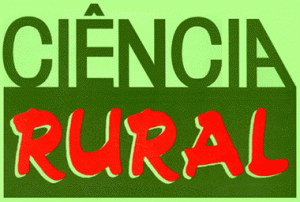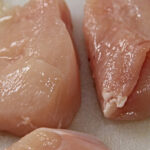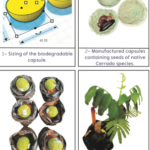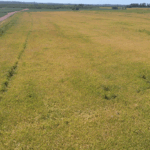Maria Luiza De Grandi, journalist from Ciência Rural, Santa Maria RS, Brazil.
Bruno Henrique Tondato Arantes, Universidade Federal do Rio Grande do Sul (UFRGS), Porto Alegre, RS, Brasil.
 Soy is one of the most cultivated plants in the world due to its versatility working both for food consumption and as raw material for the most diverse derivatives. Soybean crops have been around the world for over five thousand years and their production has been improved ever since. However, several types of stressors affect soybeans causing yield losses, particularly the soybean cyst nematode Heterodera glycines and the root lesion nematode Pratylenchus brachyurus (NIBLACK, 2005; WRATHER, KOENNING, 2006; GOULART, 2008; WANG et al, 2015; PENG et al., 2016).
Soy is one of the most cultivated plants in the world due to its versatility working both for food consumption and as raw material for the most diverse derivatives. Soybean crops have been around the world for over five thousand years and their production has been improved ever since. However, several types of stressors affect soybeans causing yield losses, particularly the soybean cyst nematode Heterodera glycines and the root lesion nematode Pratylenchus brachyurus (NIBLACK, 2005; WRATHER, KOENNING, 2006; GOULART, 2008; WANG et al, 2015; PENG et al., 2016).
Researchers from the Goiano Federal Institute (IF Goiano), in partnership with the Federal University of Rio Grande do Sul (UFRGS), developed a study with the objective of determining the best spectral band for the detection of H. glycines and P. brachyurus using linear regression models. In addition, the research defined a mathematical model to optimize its detection at the beginning of flowering. The article Spectral detection of nematodes in soybean in the flowering stage by means of unmanned aerial vehicles was published in Ciência Rural (vol. 51, no. 5).
To achieve the objectives of the study, nine collection points were defined, in five different reboleiras, totaling 45 points. The sample area of the study had approximately 330 acres and was located near the city of Rio Verde, in the state of Goiás. The evaluations took place during the 2017/2018 harvest. The flights were carried out with the Phantom 4 Advanced, Sequoia and Sentera drones (Unmanned Aerial Vehicles, UAVs), widely used in agriculture.

Imagem: Pixabay.
Research results demonstrate that soybean cyst nematode detection can be optimized using the red band of the Phantom vehicle. The simultaneous use of the red bands of the Phantom and Sentera and the green and blue bands of the Phantom (all RGB) showed promising results. For P. brachyurus, Sentera’s RedEdge presented the best R² value and was significant at 5%, however the result was even better when considered in the multiple linear regression model, the Sentera’s RedEdge and the red and NIR of the NDVI sensor.
According to Bruno Arantes, one of the authors of the research, the results can help producers who face problems with nematodes. “The producer can acquire a sensor that contains the appropriate bands for the mapping of nematode swarms, with the purpose of drawing up an application map, optimizing the consumption of water and nematicides”.
The research, with the goal to assist in the monitoring of nematodes in the soybean crop, allows, according to the researcher, field agents specifically targeted at problematic points of the crop, without the need to go through the entire field, optimizing time and resources. “In soil, samples can be extracted for the confirmation of nematodes, and therefore for a sustainable use of nematicides to combat these soil pathogens”, explains Bruno.
References
GOULART, A.M.C. Aspectos gerais sobre nematoides das lesões radiculares (gênero Pratylenchus). 1 ed. Planaltina: Embrapa Cerrados-Documentos (INFOTECA-E), 2008.
NIBLACK, T.L. et al. Shift in the virulence of soybean cyst nematode is associated with use of resistance from PI 88788. Plant Health Progress [online]. 2008, vol. 9, no. 1, pp. 29 [viewed 31 August 2022]. https://doi.org/10.1094/php-2008-0118-01-rs. Available from: https://apsjournals.apsnet.org/doi/10.1094/PHP-2008-0118-01-RS
PENG, D.L., et al. First report of soybean cyst nematode (Heterodera glycines) on soybean from Gansu and Ningxia China. Plant disease [online]. 2016, vol. 100, no. 1, pp. 229–229 [viewed 31 August 2022]. https://doi.org/10.1094%2FPDIS-04-15-0451-PDN. Available from: https://apsjournals.apsnet.org/doi/10.1094/PDIS-04-15-0451-PDN
WANG, H.M., et al. Genetic structure analysis of populations of the soybean cyst nematode, Heterodera glycines, from north China. Nematology [online]. 2015, vol. 17, no. 5, pp. 591–600 [viewed 31 August 2022]. https://doi.org/10.1163/15685411-00002893. Available from: https://brill.com/view/journals/nemy/17/5/article-p591_9.xml
WRATHER, J.A. and KOENNING, S.R. Estimates of disease effects on soybean yields in the United States 2003 to 2005. J Nematol. [online]. 2006, vol. 38, no. 2, pp. 173-180 [viewed 31 August 2022]. Available from: https://www.ncbi.nlm.nih.gov/pmc/articles/PMC2586459/
To read the article, access
ARANTES, B.H.T., et al. Spectral detection of nematodes in soybean at flowering growth stage using unmanned aerial vehicles. Cienc. Rural [online]. 2021, vol. 51, no. 5, e20200283 [viewed 31 August 2022]. https://doi.org/10.1590/0103-8478cr20200283. Available from: https://www.scielo.br/j/cr/a/YWdtrPs5k49DG3yVmbHW7hj/?lang=en
External links
Ciência Rural: http://coral.ufsm.br/ccr/cienciarural/
Ciência Rural – social media: Twitter | Instagram | Facebook
Ciência Rural – CR: https://www.scielo.br/cr/
Como citar este post [ISO 690/2010]:


















Recent Comments